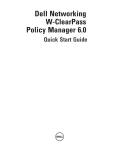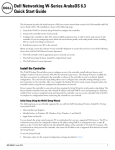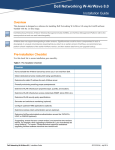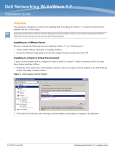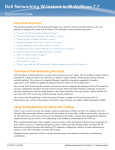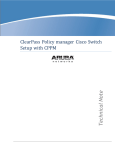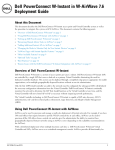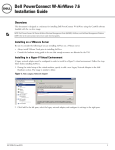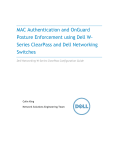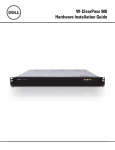Download Dell Powerconnect W-ClearPass Hardware Appliances Getting Started Guide
Transcript
Getting Started Guide Dell Networking W-ClearPass Policy Manager Copyright Information © 2014 Aruba Networks, Inc. Aruba Networks trademarks include the Aruba Networks logo, Aruba Networks®, Aruba Wireless Networks®, the registered Aruba the Mobile Edge Company logo, and Aruba Mobility Management System®. Dell™, the DELL™ logo, and PowerConnect™ are trademarks of Dell Inc. All rights reserved. Specifications in this manual are subject to change without notice. Originated in the USA. All other trademarks are the property of their respective owners. Open Source Code Certain Aruba products include Open Source software code developed by third parties, including software code subject to the GNU General Public License (GPL), GNU Lesser General Public License (LGPL), or other Open Source Licenses. Includes software from Litech Systems Design. The IF-MAP client library copyright 2011 Infoblox, Inc. All rights reserved. This product includes software developed by Lars Fenneberg, et al. The Open Source code used can be found at this site: http://www.arubanetworks.com/open_source Legal Notice The use of Aruba Networks, Inc. switching platforms and software, by all individuals or corporations, to terminate other vendors’ VPN client devices constitutes complete acceptance of liability by that individual or corporation for this action and indemnifies, in full, Aruba Networks, Inc. from any and all legal actions that might be taken against it with respect to infringement of copyright on behalf of those vendors. March 2014 | 0511213-03 Dell Networking W-W-ClearPass Policy Manager | Getting Started Guide Contents Powering Up and Configuring Policy Manager Hardware 5 Overview 5 Server Port Overview 5 Server Port Configuration 5 Powering Off the System 7 Resetting the Passwords to Factory Default 8 Generating a Support Key for Technical Support 8 A Subset of Useful CLI Commands 9 Accessing Policy Manager Accessing Help 11 12 Checking Basic Services Use Cases 13 15 802.1X Wireless Use Case 15 Configuring the Service 15 Web Based Authentication Use Case Configuring the Service MAC Authentication Use Case Configuring the Service TACACS+ Use Case Configuring the Service Single Port Use Case Dell Networking W-ClearPass Policy Manager | Getting Started Guide 21 22 28 29 31 32 33 Contents | 3 4 | Contents Dell Networking W-ClearPass Policy Manager | Getting Started Guide Chapter 1 Powering Up and Configuring Policy Manager Hardware Overview This Getting Started Guide for the Dell Networking W-W-ClearPass Policy Manager System (Policy Manager) describes the steps for installing the appliance using the Command Line Interface (CLI) and using the User Interface (UI) to ensure that the required services are running. Server Port Overview The W-ClearPass Policy Manager server requires initial port configuration. The backplane of the Policy Manager contains three ports. Figure 1: Policy Manager Backplane The ports in the figure above are described in the following table: Table 1: Device Ports Key Port Description A Serial Configures the W-ClearPass Policy Manager appliance initially using hardwired terminal. Beth0 Management (gigabit Ethernet) Provides access for cluster administration and appliance maintenance using Web access, CLI, or internal cluster communications. Configuration is mandatory. Ceth1 Data (gigabit Ethernet) Provides point of contact for RADIUS, TACACS+, Web Authentication, and other data-plane requests. Configuration is optional. If this port is not configured, requests are redirected to the management port. Server Port Configuration Before starting the installation, collect the following information that you need, write it in the table below, and keep it for your records: Table 2: Required Information Requirement Value for Your Installation Hostname (Policy Manager server) Management Port IP Address Dell Networking W-ClearPass Policy Manager | Getting Started Guide Powering Up and Configuring Policy Manager Hardware | 5 Table 2: Required Information (Continued) Requirement Value for Your Installation Management Port Subnet Mask Management Port Gateway Data Port IP Address (optional) NOTE: The Data Port IP Address must not be in the same subnet as the Management Port IP Address. Data Port Gateway (optional) Data Port Subnet Mask (optional) Primary DNS Secondary DNS NTP Server (optional) Perform the following steps to set up the Policy Manager appliance: 1. Connect and power on Connect a serial port on the appliance to a terminal using the null modem cable provided and power on. The appliance is available for configuration. Use the following parameters for the serial port connection: l Bit Rate: 9600 l Data Bits: 8 l Parity: None l Stop Bits: 1 l Flow Control: None 2. Login You can create a unique appliance/cluster administration password later. For now, use the following preconfigured credentials: login: appadmin password: eTIPS123 This initiates the Policy Manager Configuration Wizard. 3. Configure the Appliance Replace the bolded placeholder entries in the following illustration with your local information: Enter hostname: verne.xyzcompany.com Enter Management Port IP Address: 192.168.5.10 Enter Management Port Subnet Mask: 255.255.255.0 Enter Management Port Gateway: 192.168.5.1 Enter Data Port IP Address: 192.168.7.55 Enter Data Port Subnet Mask: 255.255.255.0 6 | Powering Up and Configuring Policy Manager Hardware Dell Networking W-ClearPass Policy Manager | Getting Started Guide Enter Data Port Gateway: 192.168.7.1 Enter Primary DNS: 198.168.5.3 Enter Secondary DNS: 192.168.5.1 4. Change your password Use any string with a minimum of six characters: New Password:************ Confirm Password: ************ From now, you must use this password for cluster administration and management of the appliance. 5. Change the system date/time Do you want to configure system date time information [y|n]: y Please select the date time configuration options. 1) Set date time manually 2) Set date time by configuring NTP servers Enter the option or press any key to quit: 2 Enter Primary NTP Server: pool.ntp.org Enter Secondary NTP Server: time.nist.gov Do you want to configure the timezone? [y|n]: y After the timezone information is entered, you are prompted to confirm the selection. 6. Commit or restart the configuration Follow the prompts: Proceed with the configuration [y[Y]/n[N]/q[Q] y[Y] to continue n[N] to start over again q[Q] to quit Enter the choice:Y Successfully configured Policy Manager appliance ************************************************************* * Initial configuration is complete. * Use the new login password to login to the CLI. * Exiting the CLI session in 2 minutes. Press any key to exit now. When the Policy Manager system is up and running, navigate to the Administration > Agents and Software Updates > Software Updates page to view and download any available software updates. Refer to in the User Guide for more information. Powering Off the System Perform the following steps to power off the system gracefully without logging in: Connect to the CLI from the serial console using the front serial port and enter the following: login: poweroff password: poweroff This procedure gracefully shuts down the appliance. Dell Networking W-ClearPass Policy Manager | Getting Started Guide Powering Up and Configuring Policy Manager Hardware | 7 Resetting the Passwords to Factory Default To reset Administrator passwords in Policy Manager to factory defaults, you can login to the CLI as the apprecovery user. The password to log in as the apprecovery user is dynamically generated. Perform the following steps to generate the recovery password: 1. Connect to the Policy Manager appliance using the front serial port (using any terminal program). See "Resetting the Passwords to Factory Default" on page 8 for details. 2. Reboot the system and execute the restart command. 3. After the system restarts, the following prompt is displayed for ten seconds: Generate support keys? [y/n]: Enter y at the prompt. The system prompts you with the following choices: Please select a support key generation option. 1) Generate password recovery key 2) Generate a support key 3) Generate password recovery and support keys Enter the option or press any key to quit. 4. To generate the recovery key, select option 1. 5. To generate a support key and a recovery key and support, select option 3. 6. After the password recovery key is generated, email the key to Dell technical support. A unique password will be generated from the recovery key and emailed back to you. 7. Enter the following command at the command prompt: [apprecovery] app reset-passwd ******************************************************* * WARNING: This command will reset the system account * * passwords to factory default values * ******************************************************* Are you sure you want to continue? [y/n]: y INFO - Password changed on local node INFO - System account passwords have been reset to factory default values Generating a Support Key for Technical Support To troubleshoot certain critical system level errors, Dell technical support might need to log into a support shell. Perform the following steps to generate a dynamic support password: 1. Log into the Command Line Interface (CLI) and enter the following command: system gen-support-key 2. Connect to the Policy Manager appliance using the front serial port (using any terminal program). See "Server Port Configuration" on page 5 for details. 3. Reboot the system using the restart command. 4. When the system restarts, the following prompt appears for 10 seconds: Generate support keys? [y/n]: Enter y at the prompt. The system prompts with the following choices: Please select a support key generation option. 8 | Powering Up and Configuring Policy Manager Hardware Dell Networking W-ClearPass Policy Manager | Getting Started Guide 1) Generate password recovery key 2) Generate a support key 3) Generate password recovery and support keys Enter the option or press any key to quit. 5. To generate the support key, select option 2. Select 3, if you want to generate a password recovery key as well. 6. After the password recovery key is generated, email the key to Dell technical support. A unique password can now be generated by Dell technical support to log into the support shell. A Subset of Useful CLI Commands The CLI provides a way to manage and configure Policy Manager information. Refer to Appendix A: Command Line Interface in the User Guide for more detailed information on the CLI. The CLI can be accessed from the console using a serial port interface or remotely using SSH: ***************************************************************************************** * Dell W-ClearPass Policy Manager * * Software Version : 6.3.0.62080 * ***************************************************************************************** Logged in as group Local Administrator [[email protected]]# The following subset of CLI commands may be useful at this point: l To view the Policy Manager data and management port IP address, and DNS configuration: [appadmin]# show ip l To reconfigure DNS or add a new DNS: [appadmin]# configure dns <primary> [secondary] [tertiary] l To reconfigure or add management and data ports: [appadmin]# configure ip <mgmt | data > <ipadd> netmask <netmask address> gateway <gateway address> where: l Flag/Parameter Description ip <mgmt|data> <ip address> l l Network interface type: mgmt or data Server ip address. netmask <netmask address> Netmask address. gateway <gateway address> Gateway address. To configure the date (time and time zone optional): [appadmin]# configure date –d <date> [-t <time>] [-z <timezone>] l To configure the hostname to the node: configure hostname <hostname> l If you are using Active Directory to authenticate users, be sure to join the Policy Manager appliance to that domain as well. ad netjoin <domain-controller.domain-name> [domain NETBIOS name] where: Dell Networking W-ClearPass Policy Manager | Getting Started Guide Powering Up and Configuring Policy Manager Hardware | 9 Flag/Parameter Description <domain-controller. domain-name> Required. Host to be joined to the domain. [domain NETBIOS name] Optional. 10 | Powering Up and Configuring Policy Manager Hardware Dell Networking W-ClearPass Policy Manager | Getting Started Guide Chapter 2 Accessing Policy Manager Use Firefox 3.0 (or higher) or Internet Explorer 7.0.5 (or higher) to perform the following steps: 1. Open the administrative interface. Navigate to https://<hostname>/tips, where <hostname> is the hostname you configured during the initial configuration. 2. Enter License Key. 3. Click the Activate Now link. 4. Activate the product. If the appliance is connected to the Internet, click on the Activate Now button. If not, click on the Download button to download the Activation Request Token. Contact Dell Support and provide your technician with the downloaded token in an email attachment. Once you receive the Activation Key from Dell Support, save it to a known location on your computer. Come back to this screen and click on the Browse button to select the Activation Key. Upload the key by clicking on the Upload button. The product is now activated. 5. Login. Username: admin, Password: eTIPS123 Dell Networking W-ClearPass Policy Manager | Getting Started Guide Accessing Policy Manager | 11 6. Change the password. Navigate to Administration > Admin Users, then use the Edit Admin User popup to change the administration password. Accessing Help The Policy Manager User Guide (in PDF format) is built within the help system here: https://<hostname>/tipshelp/html/en/ (where <hostname> is the hostname you configured during the initial configuration.) All Policy Manager user interface screens have context-sensitive help. To access context-sensitive help, click on the Help link at the top right hand corner of any screen. 12 | Accessing Policy Manager Dell Networking W-ClearPass Policy Manager | Getting Started Guide Chapter 3 Checking Basic Services To check the status of service, navigate to Administration > Server Manager > Server Configuration, then click on a row to select a server: l The System tab displays server identity and connection parameters. l The Service Control tab displays all services and their current status. If a service is stopped, you can use its Start/Stop button (toggle) to restart it. You can also start an individual service from the command line, service start <service-name> or all services from the command line, service start all l The Service Parameters tab allows you to change system parameters for all services. l The System Monitoring tab allows you to configure SNMP parameters, ensuring that external MIB browsers can browse the system-level MIB objects exposed by the Policy Manager appliance. l The Network tab allows you to view and create GRE tunnels and VLANs. l The FIPS tab is used to enable W-ClearPass in Federal Information Processing Standard mode. For most users, this tab should be ignored. Changing the mode to FIPS mode causes the database to be reset. Dell Networking W-ClearPass Policy Manager | Getting Started Guide Checking Basic Services | 13 14 | Checking Basic Services Dell Networking W-ClearPass Policy Manager | Getting Started Guide Appendix A Use Cases This appendix contains several specific W-ClearPass Policy Manager use cases. Each one explains what it is typically used for, and then describes how to configure Policy Manager for that use case. l "802.1X Wireless Use Case" on page 15 l "Web Based Authentication Use Case" on page 21 l "MAC Authentication Use Case" on page 28 l "TACACS+ Use Case" on page 31 l "Single Port Use Case" on page 33 802.1X Wireless Use Case The basic Policy Manager Use Case configures a Policy Manager Service to identify and evaluate an 802.1X request from a user logging into a Wireless Access Device. The following image illustrates the flow of control for this Service. Figure 2: Flow of Control, Basic 802.1X Configuration Use Case Configuring the Service Follow the steps below to configure this basic 802.1X service: 1. Create the Service. The following table provides the model for information presented in Use Cases, which assume the reader’s ability to extrapolate from a sequence of navigational instructions (left column) and settings (in summary form in the right Dell Networking W-ClearPass Policy Manager | Getting Started Guide Use Cases | 15 column) at each step. Below the table, we call attention to any fields or functions that may not have an immediately obvious meaning. Policy Manager ships with fourteen preconfigured Services. In this Use Case, you select a Service that supports 802.1X wireless requests. Table 3: 802.1X - Create Service Navigation and Settings Navigation Settings Create a new Service: Services > l Add Service (link) > l Name the Service and select a preconfigured Service Type: l Service (tab) > l Type (selector): 802.1X Wireless > l Name/Description (freeform) > l Upon completion, click Next (to Authentication) The following fields deserve special mention: n Monitor Mode: Optionally, check here to allow handshakes to occur (for monitoring purposes), but without enforcement. n Service Categorization Rule: For purposes of this Use Case, accept the preconfigured Service Categorization Rules for this Type. 2. Configure Authentication. Follow the instructions to select [EAP FAST], one of the pre-configured Policy Manager Authentication Methods, and Active Directory Authentication Source (AD), an external Authentication Source within your existing enterprise. Policy Manager fetches attributes used for role mapping from the Authorization Sources (that are associated with the authentication source). In this example, the authentication and authorization source are one and the same. 16 | Use Cases Dell Networking W-ClearPass Policy Manager | Getting Started Guide Table 4: Configure Authentication Navigation and Settings Navigation Settings Select an Authentication Method and an Active Directory server (that you have already configured in Policy Manager): l Authentication (tab) > l Methods (Select a method from the drop-down list) l Add > l Sources (Select drop-down list): [Local User Repository] [Local SQL DB] [Guest User Repository] [Local SQL DB] [Guest Device Repository] [Local SQL DB] [Endpoints Repository] [Local SQL DB] [Onboard Devices Repository] [Local SQL DB] > [Admin User Repository] [Local SQL DB] > AmigoPod AD [Active Directory> l Add > l Upon completion, Next (to configure Authorization) The following field deserves special mention: n Strip Username Rules: Optionally, check here to pre-process the user name (to remove prefixes and suffixes) before sending it to the authentication source. To view detailed setting information for any preconfigured policy component, select the item and click View Details. 3. Configure Authorization. Policy Manager fetches attributes for role mapping policy evaluation from the Authorization Sources. In this use case, the Authentication Source and Authorization Source are one and the same. Dell Networking W-ClearPass Policy Manager | Getting Started Guide Use Cases | 17 Table 5: 02.1X - Configure Authorization Navigation and Settings Navigation l l Settings Configure Service level authorization source. In this use case there is nothing to configure. Click the Next button. Upon completion, click Next (to Role Mapping). 4. Apply a Role Mapping Policy. Policy Manager tests client identity against role-mapping rules, appending any match (multiple roles acceptable) to the request for use by the Enforcement Policy. In the event of role-mapping failure, Policy Manager assigns a default role. In this Use Case, create the role mapping policy RMP_DEPARTMENT that distinguishes clients by department and the corresponding roles ROLE_ENGINEERING and ROLE_FINANCE, to which it maps: Table 6: Role Mapping Navigation and Settings Navigation Settings Create the new Role Mapping Policy: Roles (tab) > l Add New Role Mapping Policy (link) > l Add new Roles (names only): Policy (tab) > l Policy Name (freeform): ROLE_ ENGINEER > l Save (button) > l Repeat for ROLE_FINANCE > l When you are finished working in the Policy tab, click the Next button (in the Rules Editor) l 18 | Use Cases Dell Networking W-ClearPass Policy Manager | Getting Started Guide Table 6: Role Mapping Navigation and Settings (Continued) Navigation Settings Create rules to map client identity to a Role: l Mapping Rules (tab) > l Rules Evaluation Algorithm (radio button): Select all matches > l Add Rule (button opens popup) > l Add Rule (button) > l Rules Editor (popup) > l Conditions/ Actions: match Conditions to Actions (drop-down list) > l Upon completion of each rule, click the Save button ( in the Rules Editor) > l When you are finished working in the Mapping Rules tab, click the Save button (in the Mapping Rules tab) Add the new Role Mapping Policy to the Service: l Back in Roles (tab) > l Role Mapping Policy (selector): RMP_ DEPARTMENT > l Upon completion, click Next (to Posture) 5. Configure a Posture Server. For purposes of posture evaluation, you can configure a Posture Policy (internal to Policy Manager), a Posture Server (external), or an Audit Server (internal or external). Each of the first three use cases demonstrates one of these options; here, the Posture Server. Policy Manager can be configured for a third-party posture server, to evaluate client health based on vendor-specific credentials, typically credentials that cannot be evaluated internally by Policy Manager (that is, not in the form of internal posture policies). Currently, Policy Manager supports the following posture server interface: Microsoft NPS (RADIUS). Refer to the following table to add the external posture server of type Micrsoft NPS to the 802.1X service: Dell Networking W-ClearPass Policy Manager | Getting Started Guide Use Cases | 19 Table 7: Posture Navigation and Settings Navigation Setting Add a new Posture Server: Posture (tab) > l Add new Posture Server (button) > l Configure Posture settings: Posture Server (tab) > l Name (freeform): PS_NPS l Server Type (radio button): Microsoft NPS l Default Posture Token (selector): UNKOWN l Next (to Primary Server) l Configure connection settings: Primary/ Backup Server (tabs): Enter connection information for the RADIUS posture server. l Next (button): from Primary Server to Backup Server. l To complete your work in these tabs, click the Save button. l Add the new Posture Server to the Service: l Back in the Posture (tab) > l Posture Servers (selector): PS_ NPS, then click the Add button. l Click the Next button. 6. Assign an Enforcement Policy. Enforcement Policies contain dictionary-based rules for evaluation of Role, Posture Tokens, and System Time to Evaluation Profiles. Policy Manager applies all matching Enforcement Profiles to the Request. In the case of no match, Policy Manager assigns a default Enforcement Profile. 20 | Use Cases Dell Networking W-ClearPass Policy Manager | Getting Started Guide Table 8: Enforcement Policy Navigation and Settings Navigation Setting Configure the Enforcement Policy: l Enforcement (tab) > l Enforcement Policy (selector): Role_Based_ Allow_Access_ Policy For instructions about how to build such an Enforcement Policy, refer to "Configuring Enforcement Policies" in the W-ClearPass Policy Manager User Guide. 7. Save the Service. Click Save. The Service now appears at the bottom of the Services list. Web Based Authentication Use Case This Service supports known Guests with inadequate 802.1X supplicants or posture agents. The following figure illustrates the overall flow of control for this Policy Manager Service. Dell Networking W-ClearPass Policy Manager | Getting Started Guide Use Cases | 21 Figure 3: Flow-of-Control of Web-Based Authentication for Guests Configuring the Service Perform the following steps to configure Policy Manager for WebAuth-based Guest access. 1. Prepare the switch to pre-process WebAuth requests for the Policy Manager Dell WebAuth service. Refer to your Network Access Device documentation to configure the switch such that it redirects HTTP requests to the Dell Guest Portal, which captures username and password and optionally launches an agent that returns posture data. 2. Create a WebAuth-based Service. Table 9: Service Navigation and Settings Navigation Settings Create a new Service: l Services > l Add Service > 22 | Use Cases Dell Networking W-ClearPass Policy Manager | Getting Started Guide Table 9: Service Navigation and Settings (Continued) Navigation Settings Name the Service and select a pre-configured Service Type: l Service (tab) > l Type (selector): Dell Web-Based Authentication > l Name/Description (freeform) > l Upon completion, click Next. 3. Set up the Authentication. a. Method: The Policy Manager WebAuth service authenticates WebAuth clients internally. b. Source: Administrators typically configure Guest Users in the local Policy Manager database. 4. Configure a Posture Policy. For purposes of posture evaluation, you can configure a Posture Policy (internal to Policy Manager), a Posture Server (external), or an Audit Server (internal or external). Each of the first three use cases demonstrates one of these options. This use case demonstrates the Posture Policy. As of the current version, Policy Manager ships with five pre-configured posture plugins that evaluate the health of the client and return a corresponding posture token. To add the internal posture policy IPP_UNIVERSAL_XP, which (as you will configure it in this Use Case, checks any Windows® XP clients to verify the most current Service Pack). Dell Networking W-ClearPass Policy Manager | Getting Started Guide Use Cases | 23 Table 10: Local Policy Manager Database Navigation and Settings Navigation Settings Select the local Policy Manager database: l Authentication (tab) > l Sources (Select drop-down list): [Local User Repository] > l Add > l Strip Username Rules (check box) > l Enter an example of preceding or following separators (if any), with the phrase “user” representing the username to be returned. For authentication, Policy Manager strips the specified separators and any paths or domains beyond them. l Upon completion, click Next (until you reach Enforcement Policy). Table 11: Posture Policy Navigation and Settings Navigation Setting Create a Posture Policy: l Posture (tab) > l Enable Validation Check (check box) > l Add new Internal Policy (link) > 24 | Use Cases Dell Networking W-ClearPass Policy Manager | Getting Started Guide Table 11: Posture Policy Navigation and Settings (Continued) Navigation Setting Name the Posture Policy and specify a general class of operating system: l Policy (tab) > l Policy Name (freeform): IPP_ UNIVERSAL > l Host Operating System (radio buttons): Windows > l When finished working in the Policy tab, click Next to open the Posture Plugins tab Select a Validator: Posture Plugins (tab) > l Enable Windows Health System Validator > l Configure (button) > l Dell Networking W-ClearPass Policy Manager | Getting Started Guide Use Cases | 25 Table 11: Posture Policy Navigation and Settings (Continued) Navigation Setting Configure the Validator: l Windows System Health Validator (popup) > l Enable all Windows operating systems (check box) > l Enable Service Pack levels for Windows 7, Windows Vista®, Windows XP Windows Server® 2008, Windows Server 2008 R2, and Windows Server 2003 (check boxes) > l Save (button) > l When finished working in the Posture Plugin tab click Next to move to the Rules tab) 26 | Use Cases Dell Networking W-ClearPass Policy Manager | Getting Started Guide Table 11: Posture Policy Navigation and Settings (Continued) Navigation Setting Set rules to correlate validation results with posture tokens: l Rules (tab) > l Add Rule (button opens popup) > l Rules Editor (popup) > l Conditions/ Actions: match Conditions (Select Plugin/ Select Plugin checks) to Actions (Posture Token)> l In the Rules Editor, upon completion of each rule, click the Save button > l When finished working in the Rules tab, click the Next button. Add the new Posture Policy to the Service: Back in Posture (tab) > Internal Policies (selector): IPP_ UNIVERSAL_XP, then click the Add button The following fields deserve special mention: n Default Posture Token. Value of the posture token to use if health status is not available. n Remediate End-Hosts. When a client does not pass posture evaluation, redirect to the indicated server for remediation. n Remediation URL. URL of remediation server. 5. Create an Enforcement Policy. Because this Use Case assumes the Guest role, and the Dell Web Portal agent has returned a posture token, it does not require configuration of Role Mapping or Posture Evaluation. Dell Networking W-ClearPass Policy Manager | Getting Started Guide Use Cases | 27 The SNMP_POLICY selected in this step provides full guest access to a Role of [Guest] with a Posture of Healthy, and limited guest access. Table 12: Enforcement Policy Navigation and Settings Navigation Setting Add a new Enforcement Policy: l Enforcement (tab) > l Enforcement Policy (selector): SNMP_ POLICY l Upon completion, click Save. 6. Save the Service. Click Save. The Service now appears at the bottom of the Services list. MAC Authentication Use Case This Service supports Network Devices, such as printers or handhelds. The following image illustrates the overall flow of control for this Policy Manager Service. In this service, an audit is initiated on receiving the first MAC Authentication request. A subsequent MAC Authentication request (forcefully triggered after the audit, or triggered after a short session timeout) uses the cached results from the audit to determine posture and role(s) for the device. 28 | Use Cases Dell Networking W-ClearPass Policy Manager | Getting Started Guide Figure 4: Flow-of-Control of MAC Authentication for Network Devices Configuring the Service Follow these steps to configure Policy Manager for MAC-based Network Device access. 1. Create a MAC Authentication Service. Table 13: MAC Authentication Service Navigation and Settings Navigation Settings Create a new Service: l Services > l Add Service (link) > Dell Networking W-ClearPass Policy Manager | Getting Started Guide Use Cases | 29 Table 13: MAC Authentication Service Navigation and Settings (Continued) Navigation Settings Name the Service and select a pre-configured Service Type: l Service (tab) > l Type (selector): MAC Authentication > l Name/Description (freeform) > l Upon completion, click Next to configure Authentication 2. Set up Authentication. You can select any type of authentication/authorization source for a MAC Authentication service. Only a Static Host list of type MAC Address List or MAC Address Regular Expression shows up in the list of authentication sources (of type Static Host List). Refer to "Adding and Modifying Static Host Lists" in the ClearPass Policy Manager User Guide for more information. You can also select any other supported type of authentication source. Table 14: Authentication Method Navigation and Settings Navigation Settings Select an Authentication Method and two authentication sources - one of type Static Host List and the other of type Generic LDAP server (that you have already configured in Policy Manager): l Authentication (tab) > l Methods (This method is automatically selected for this type of service): [MAC AUTH] > l Add > l Sources (Select drop-down list): Handhelds [Static Host List] and Policy Manager Clients White List [Generic LDAP] > l Add > l Upon completion, Next (to Audit) 3. Configure an Audit Server. This step is optional if no Role Mapping Policy is provided, or if you want to establish health or roles using an audit. An audit server determines health by performing a detailed system and health vulnerability analysis (NESSUS). You can also configure the audit server (NMAP or NESSUS) with post-audit rules that enable Policy Manager to determine client identity. 30 | Use Cases Dell Networking W-ClearPass Policy Manager | Getting Started Guide Table 15: Audit Server Navigation and Settings Navigation Settings Configure the Audit Server: l Audit (tab) > l Audit End Hosts (enable) > l Audit Server (selector): NMAP l Trigger Conditions (radio button): For MAC authentication requests l Reauthenticate client (check box): Enable Upon completion of the audit, Policy Manager caches Role (NMAP and NESSUS) and Posture (NESSUS), then resets the connection (or the switch reauthenticates after a short session timeout), triggering a new request, which follows the same path until it reaches Role Mapping/Posture/Audit; this appends cached information for this client to the request for passing to Enforcement. Select an Enforcement Policy. 4. Select the Enforcement Policy Sample_Allow_Access_Policy: Table 16: Enforcement Policy Navigation and Settings Navigation Setting Select the Enforcement Policy: Enforcement (tab) > l Use Cached Results (check box): Select Use cached Roles and Posture attributes from previous sessions > l Enforcement Policy (selector): UnmanagedClientPolicy l When you are finished with your work in this tab, click Save. l Unlike the 802.1X Service, which uses the same Enforcement Policy (but uses an explicit Role Mapping Policy to assess Role), in this use case Policy Manager applies post-audit rules against attributes captured by the Audit Server to infer Role(s). 5. Save the Service. Click Save. The Service now appears at the bottom of the Services list. TACACS+ Use Case This Service supports Administrator connections to Network Access Devices via TACACS+. The following image illustrates the overall flow of control for this Policy Manager Service. Dell Networking W-ClearPass Policy Manager | Getting Started Guide Use Cases | 31 Figure 5: Administrator connections to Network Access Devices via TACACS+ Configuring the Service Perform the following steps to configure Policy Manager for TACACS+-based access: 1. Create a TACACS+ Service. Table 17: TACACS+ Navigation and Settings Navigation Settings Create a new Service: Services > l Add Service (link) > l Name the Service and select a preconfigured Service Type: l Service (tab) > l Type (selector): [Policy Manager Admin Network Login Service] > l Name/Description (freeform) > l Upon completion, click Next (to Authentication) 2. Set up the Authentication. a. Method: The Policy Manager TACACS+ service authenticates TACACS+ requests internally. 32 | Use Cases Dell Networking W-ClearPass Policy Manager | Getting Started Guide b. Source: For purposes of this use case, Network Access Devices authentication data will be stored in the Active Directory. Table 18: Active Directory Navigation and Settings Navigation Settings Select an Active Directory server (that you have already configured in Policy Manager): l Authentication (tab) > l Add > l Sources (Select drop-down list): AD (Active Directory) > l Add > l Upon completion, click Next (to Enforcement Policy) 3. Select an Enforcement Policy. Select the Enforcement Policy [Admin Network Login Policy] that distinguishes the two allowed roles (Net Admin Limited and Device SuperAdmin. Table 19: Enforcement Policy Navigation and Settings Navigation Setting Select the Enforcement Policy: Enforcement (tab) > l Enforcement Policy (selector): Device Command Authorization Policy l When you are finished with your work in this tab, click Save. l 4. Save the Service. Click Save. The Service now appears at the bottom of the Services list. Single Port Use Case This Service supports all three types of connections on a single port. The following figure illustrates both the overall flow of control for this hybrid service, in which complementary switch and Policy Manager configurations allow all three types of connections on a single port: Dell Networking W-ClearPass Policy Manager | Getting Started Guide Use Cases | 33 Figure 6: Flow of the Multiple Protocol Per Port Case 34 | Use Cases Dell Networking W-ClearPass Policy Manager | Getting Started Guide


































